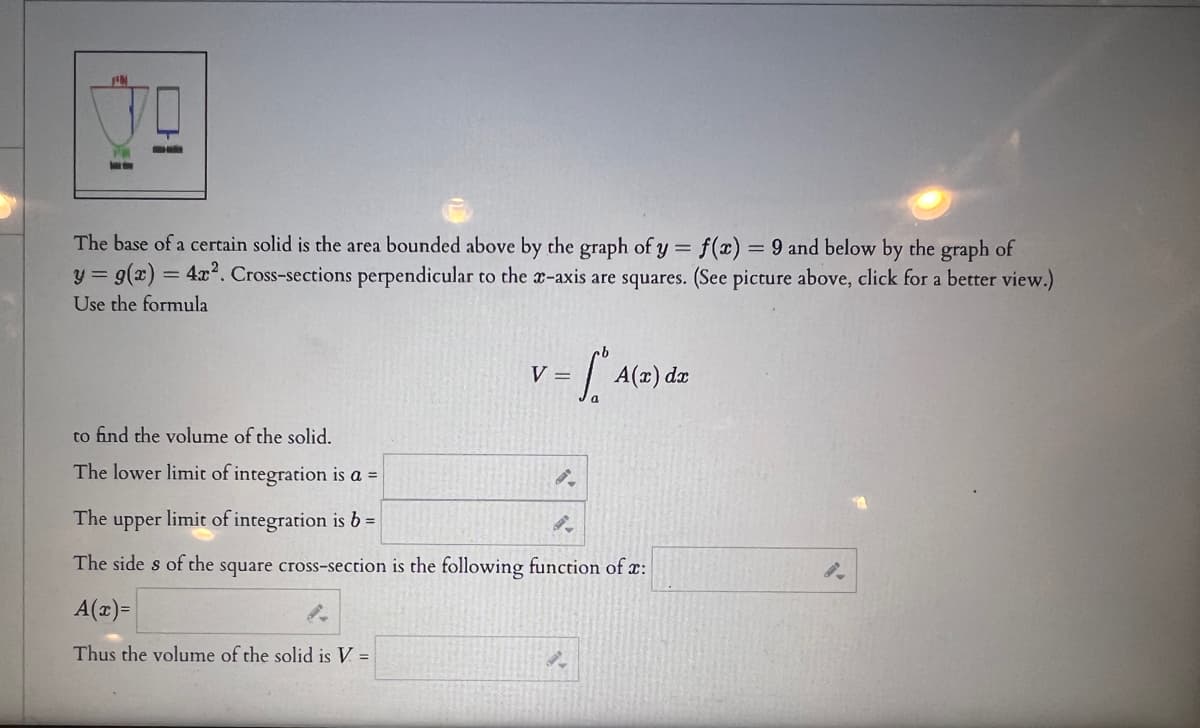PM The base of a certain solid is the area bounded above by the graph of y = f(x) = 9 and below by the graph of y = g(x) = 4x². Cross-sections perpendicular to the x-axis are squares. (See picture above, click for a better view.) Use the formula -A(z) dz V = to find the volume of the solid. The lower limit of integration is a = The upper limit of integration is b = 9. The sides of the square cross-section is the following function of x: A(x)= Thus the volume of the solid is V. = 9.
PM The base of a certain solid is the area bounded above by the graph of y = f(x) = 9 and below by the graph of y = g(x) = 4x². Cross-sections perpendicular to the x-axis are squares. (See picture above, click for a better view.) Use the formula -A(z) dz V = to find the volume of the solid. The lower limit of integration is a = The upper limit of integration is b = 9. The sides of the square cross-section is the following function of x: A(x)= Thus the volume of the solid is V. = 9.
Functions and Change: A Modeling Approach to College Algebra (MindTap Course List)
6th Edition
ISBN:9781337111348
Author:Bruce Crauder, Benny Evans, Alan Noell
Publisher:Bruce Crauder, Benny Evans, Alan Noell
ChapterA: Appendix
SectionA.2: Geometric Constructions
Problem 10P: A soda can has a volume of 25 cubic inches. Let x denote its radius and h its height, both in...
Related questions
Question

Transcribed Image Text:PM
PM
The base of a certain solid is the area bounded above by the graph of y = f(x) = 9 and below by the graph of
y = g(x) = 4x². Cross-sections perpendicular to the x-axis are squares. (See picture above, click for a better view.)
Use the formula
to find the volume of the solid.
The lower limit of integration is a =
The
v = f* A(z) dz
V
4.
e upper limit of integration is b =
The sides of the square cross-section is the following function of x:
A(x)=
Thus the volume of the solid is V =
8.
Expert Solution
This question has been solved!
Explore an expertly crafted, step-by-step solution for a thorough understanding of key concepts.
This is a popular solution!
Trending now
This is a popular solution!
Step by step
Solved in 3 steps with 1 images

Recommended textbooks for you

Functions and Change: A Modeling Approach to Coll…
Algebra
ISBN:
9781337111348
Author:
Bruce Crauder, Benny Evans, Alan Noell
Publisher:
Cengage Learning

Functions and Change: A Modeling Approach to Coll…
Algebra
ISBN:
9781337111348
Author:
Bruce Crauder, Benny Evans, Alan Noell
Publisher:
Cengage Learning